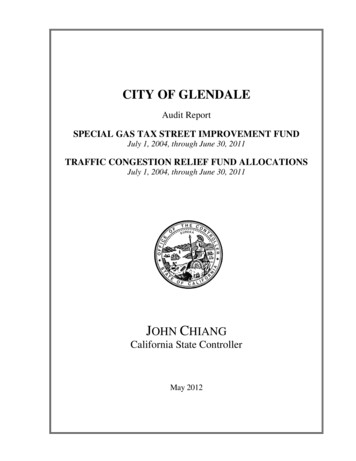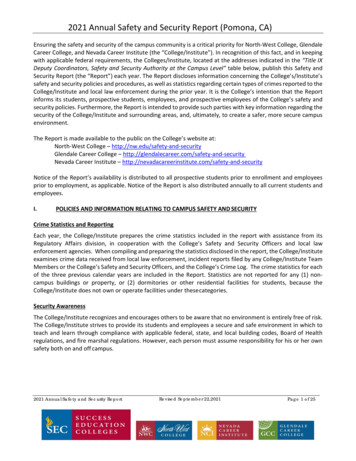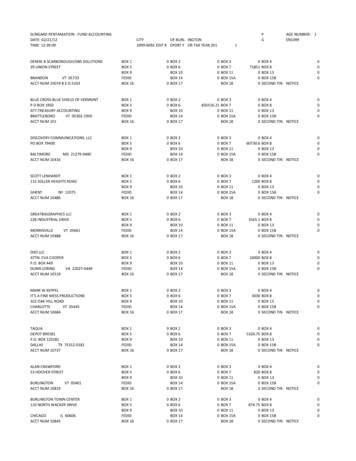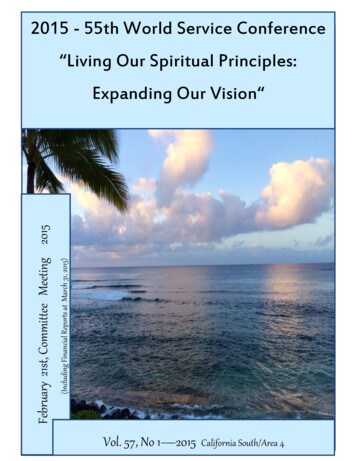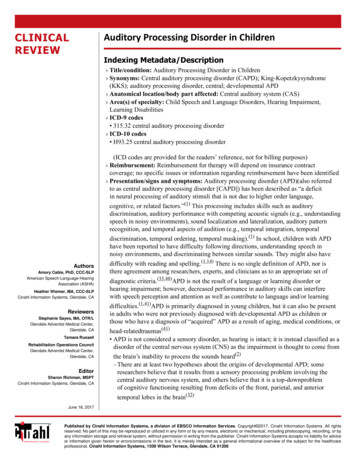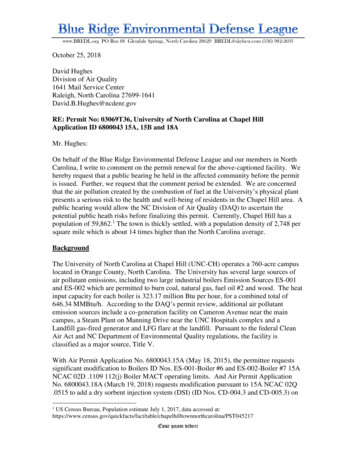
Transcription
www.BREDL.org PO Box 88 Glendale Springs, North Carolina 28629 BREDL@skybest.com (336) 982-2691October 25, 2018David HughesDivision of Air Quality1641 Mail Service CenterRaleigh, North Carolina 27699-1641David.B.Hughes@ncdenr.govRE: Permit No: 03069T36, University of North Carolina at Chapel HillApplication ID 6800043 15A, 15B and 18AMr. Hughes:On behalf of the Blue Ridge Environmental Defense League and our members in NorthCarolina, I write to comment on the permit renewal for the above-captioned facility. Wehereby request that a public hearing be held in the affected community before the permitis issued. Further, we request that the comment period be extended. We are concernedthat the air pollution created by the combustion of fuel at the University’s physical plantpresents a serious risk to the health and well-being of residents in the Chapel Hill area. Apublic hearing would allow the NC Division of Air Quality (DAQ) to ascertain thepotential public heath risks before finalizing this permit. Currently, Chapel Hill has apopulation of 59,862.1 The town is thickly settled, with a population density of 2,748 persquare mile which is about 14 times higher than the North Carolina average.BackgroundThe University of North Carolina at Chapel Hill (UNC-CH) operates a 760-acre campuslocated in Orange County, North Carolina. The University has several large sources ofair pollutant emissions, including two large industrial boilers Emission Sources ES-001and ES-002 which are permitted to burn coal, natural gas, fuel oil #2 and wood. The heatinput capacity for each boiler is 323.17 million Btu per hour, for a combined total of646.34 MMBtu/h. According to the DAQ’s permit review, additional air pollutantemission sources include a co-generation facility on Cameron Avenue near the maincampus, a Steam Plant on Manning Drive near the UNC Hospitals complex and aLandfill gas-fired generator and LFG flare at the landfill. Pursuant to the federal CleanAir Act and NC Department of Environmental Quality regulations, the facility isclassified as a major source, Title V.With Air Permit Application No. 6800043.15A (May 18, 2015), the permittee requestssignificant modification to Boilers ID Nos. ES-001-Boiler #6 and ES-002-Boiler #7 15ANCAC 02D .1109 112(j) Boiler MACT operating limits. And Air Permit ApplicationNo. 6800043.18A (March 19, 2018) requests modification pursuant to 15A NCAC 02Q.0515 to add a dry sorbent injection system (DSI) (ID Nos. CD-004.3 and CD-005.3) on1US Census Bureau, Population estimate July 1, 2017, data accessed apelhilltownnorthcarolina/PST045217Esse quam videri
Page 210/25/2018each of ES-001-Boiler #6 and ES-002-Boiler #7. The permittee has also requested thatthe current 15A NCAC 02D 112(j) Case-by-Case MACT permit conditions which areapplicable to all six boilers located on the UNC-CH campus (ID Nos. ES-001-Boiler #6,ES-002-Boiler #7, ES-003-#8, ES-004-Boiler #9, ES-005-Boiler #10 and ES-SB-6) bereplaced with a generic interim permit condition requiring compliance of the boilers with15A NCAC 02D .1111 MACT 40 CFR 63, Subpart DDDDD.CommentsThe actual air pollution emission levels of criteria pollutants and hazardous air pollutantsfrom UNC-CH, as reported to the NC DAQ, are illustrated in Charts A and B, below.2Total Air Pollutant Emissions 2012-2016Chart A: UNC-CH Emissions, 2Nox20152016COAs shown above in Chart A, the sulfur dioxide (SO2) emissions have increased by 50%during the most recent five-year period. Carbon monoxide (CO) emissions haveremained at about the same level. And nitrogen oxide (NOx) emissions have been reducedby about 28%. Chart B shows the trends for volatile organic compounds (VOC) and fineparticulate matter (PM-10) remaining stable, but hazardous air pollutants (HAP) show anincreasing trend of 58% with a startling increase in 2015 of 113%. The hazardous airpollutant responsible for 80% to 90% of the HAP total is hydrogen chloride (HCl). HClvapor is heavier than air and may concentrate in low-lying areas. Hydrogen chlorideforms corrosive hydrochloric acid on contact with water found in body tissue. Inhalationof the fumes can cause coughing, choking, inflammation of the nose, throat, and upperrespiratory tract, and in severe cases, pulmonary edema, circulatory system failure, anddeath. Skin contact can cause redness, pain, and severe skin burns. Hydrogen chloridemay cause severe burns to the eye and permanent eye damage.2Application Review, North Carolina Division of Air Quality, Facility ID 6800043, Permit No. 03069T35Esse quam videri
Page 310/25/2018Chart B: UNC-CH Emissions 6HAPConclusionThe health risks presented by the pollutants outlined above must be reduced. Theattachments to these comments and the letters submitted separately will attest to the needfor a public hearing on this permit and a comment extension.Respectfully,Louis A. ZellerAttachmentsCC: Martin, Sharon L. sharon.martin@ncdenr.gov Esse quam videri
Page 410/25/2018ATTACHMENT AOctober 18, 2018David HughesDivision of Air Quality1641 Mail Service CenterRaleigh, North Carolina 27699-1641David.b.hughes@ncdenr.govMr. Hughes,As a person disabled by Toxicant Induced Loss of Tolerance I have experienced increased and chronicbreathing and other health problems since living in Chapel Hill, North Carolina I am desperatelyinterested in the Air Quality Permit for:The University of North Carolina at Chapel Hill1120 Estes Drive ExtensionChapel Hill, North Carolina 27599-1650Orange CountyApplication ID 6800043 15A, 15B and 18APermit No: 03069T36Please accept my written request for a public hearing, with the U.S Environmental Protection Agencypresent. I also request that the public comment period be extended by 60 days to allow time to obtainand review the pertinent records. Please send me the information offered in the public notice: copies ofthe permit, permit application, all other relevant supporting materials, and all other materials available toDAQ including any notices of violation, fines, reports of non compliance or complaints of health affectsor other complaints. If this information is not available on the internet I request that it be madeavailable to the public on a public website. As a disability access provision I request this information beemailed to me at the email address below.Civic minded citizens are currently engaged in the election process and additional time is needed for usto consider this source of pollution. It is important that a public hearing be allowed to present healthinformation and consider appropriate alternatives as well as consider all aspects of the proposed permit.I want to make my reasons known in a public hearing why I am opposed to renewal of this permit. Irepresent a significant sensitive subpopulation of disabled individuals that suffer from Toxicant InducedLoss of Tolerance that deserve to be recognized and heard. We are not disposable. My health has beenimpaired by the poor air quality in this area. I recently have had surgery and radiation treatment forcancer and can ill afford these additional assaults on my health. I ask that this permit be denied andmore appropriate renewable energy such as solar panels be used alternatively. It is unconscionable that adirty energy source could be allowed to exist and the permit be renewed in this residential area whereyoung people study.Sincerely,Elizabeth M. T. O’Nan420 Hickory DriveChapel Hill NC 27517Esse quam videri
Page 510/25/2018Pbone: 655 0376email: pace@mcdowell.main.nc.usATTACHMENT B-----Original Message----From: Elizabeth O'Nan pace@mcdowell.main.nc.us Sent: Wednesday, October 24, 2018 10:52 PMTo: Lou & Janet Zeller BREDL@skybest.com Subject: Coal plant permitHi Lou and Janet,I small bit of good news to share. I attended the Chapel Hill Town meeting tonight afterspeaking with our mayor today and learning that the city had not been notified of thechange in the permit. Within about an hour of my meeting with the mayor and before thetown hall meeting started the received an apologist letter from UNC saying the permitwas for all good things at their cogeneration plant. The long and short of it is it is stillmore combustion and substantially increased pollution. I attended the meeting andpresented an emergency petition that the city submit a letter to DAQ requesting a publicmeeting and extending the comment time by 60 days as the least that could be done.They took an immediate vote and supported it unanimously.ATTACHMENT CFrom: Ed Harrison edcharrison@gmail.com Subject: Re: [Little Ridgefield] Local air pollution alertDate: October 20, 2018 at 11:12:44 AM EDTTo: littleridgefield@googlegroups.comReply-To: littleridgefield@googlegroups.comIt appears to me that the person who compiled the permit letter to Jonathan Pruitt, the relatively new ViceChancellor of Finance and Operations (about 8 months in the job) has reversed the address of the UNCdepartment office responsible for permit compliance, and the location of the sizable co-generation plant at200 East Cameron Avenue. That would be the facility which needs a renewal of "Air Quality Permit No.03069T36 to The University of North Carolina at Chapel Hill, 200 E.Cameron Avenue, CB#1000, ChapelHill, North Carolina” — the permit brought up by the second link.That address is at the far western end of the main UNC campus, about 4 air miles from Little Ridgefield.1120 Estes Drive Extension is in the UNC campus extension area about 2.5 miles drive from LittleRidgefield. It’s the building which houses the UNC Office of Environmental Health and Safety. havenever encountered any “coal burning power plant” in that area.The “Estes” near Little Ridgefield is *South* Estes Extension.The Co-Gen plant is the primary source of power generation for the UNC Main Campus. I seriously doubtthat it will be closed, but pressure does need to be maintained to convert the fuel sources. Once UNC paysoff the bond for the plant construction, they will be better positioned to do this. I can supplycorrespondence to me from Mr Pruitt’s predecessor on the process they are carrying out for thisconversion. A close associate of mine, the executive director of the NC Sierra Club, has been in meetingEsse quam videri
Page 610/25/2018with UNC-CH administrators for many years about this. The Cameron Avenue power plant was the subjectof a major National Sierra Club campaign in the previous decade, and the “Beyond Coal” effort of thenational organization has not dropped it as an issue.In my 43 professional years as an environmental manager, I have never seen a weirder address screw-up inan official permit document.Ed HarrisonEsse quam videri
www.BREDL.org PO Box 88 Glendale Springs, North Carolina 28629 BREDL@skybest.com (336) 982-2691 Esse quam videri October 25, 2018 David Hughes Division of Air Quality 1641 Mail Service Center Raleigh, North Carolina 27699-1641 David.B.Hughes@ncdenr.gov RE: Permit No: 03069T36, University of North Carolina at Chapel Hill

